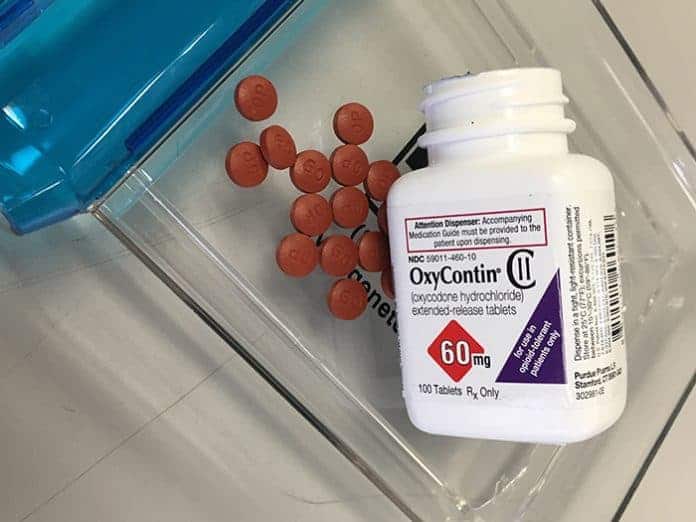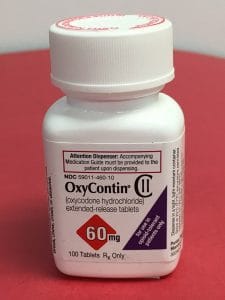
BRICK – The township has joined other cities and states in filing a lawsuit against companies that manufacture opioids, and has retained the national law firm of Motley Rice, LLC who would receive no money unless they are successful in their litigation.
During a recent council meeting, Mayor John G. Ducey said the grounds for a lawsuit is based on the opioid manufacturers’ claims to patients and medical providers that OxyContin was not addictive since it was a pill, and that only injectable or sniff-able drugs could become addictive.
“So they said don’t worry, these are pills,” Ducey said. “That’s the way they got the OxyContin out to the various doctors and patients, and everyone was requesting it, and doctors were asking for more. People were addicted to it, and the advice from the pharmaceutical companies was basically just increase the dosage to your patients and that will help the problem,” Ducey said.
When prescriptions ran out and people could no longer get the OxyContin legally, some would pay $30 to $40 for one pill on the street, so many turned to heroin, which only cost $3 to $4 for an even stronger high.
Motley Rice, LLC would receive no payment from Brick of any kind, but would get 25 percent of any settlement monies while the township would receive 75 percent, Ducey said.
“We want to hold the manufacturers of these opioids accountable for telling doctors and patients that opioids are not addictive. They know it’s not true,” he said.
There were 92 drug overdoses in Brick this year, which is a decrease from last year, Ducey said. The overdoses include Narcan revives, people brought to the hospital, and some deaths.
Councilwoman Marianna Pontoriero noted that Motley Rice, LLC has a vested interest in winning the lawsuit, “otherwise they get nothing,” she said.
Township Attorney Kevin Starkey called Motley Rice “a very aggressive and very creative law firm. They have had great success. They took the lead in suing tobacco companies back in the 90s and they also have an ongoing lawsuit representing 9/11 victims against some foreign governments. They are very knowledgeable,” he said.
The firm asked Brick Township to put together a damages report, or what the opioid crisis has cost the town in hard numbers.
Ducey said the damages include the cost of police detectives and regular police officers, investigation costs, Narcan revivals, the actual Narcan costs, the police and EMS training, hospital transport for overdose victims, and education for DARE officers.
“It’s everything you can think of as far as what’s related to the heroin and opioid problem here in Brick Township,” the mayor said. “These are the damages we are seeking for partially being responsible for the problem.”
It is very important that the township be the plaintiff so it has control over the lawsuit, Ducey added.
The township gets to choose the law firm it wants, and if Brick is not listed as the plaintiff, the township could be lumped into a class-action lawsuit with the bulk of the judgement going to lawyer fees, he said.
“When we get the funds, whatever those funds are, we want to keep on attacking the epidemic, and that’s where we want the money to go, that’s what it’s for,” Ducey said.
Councilwoman and BMAC Chair Andrea Zapcic said that OxyContin was the first 12-hour sustained relief pain pill on the market.
“The only problem was that it didn’t last 12 hours, and Purdue Pharma knew that,” she said.

When doctors started to complain about their patients not getting 12 hours of relief, the sales reps were told to go back to the doctors and tell them to “double down” and increase the dosage, but insurance companies were balking at the increased cost, she said.
The federal government and Justice Department launched an investigation in 2007 against Purdue Pharma and three executives pleaded guilty to downplaying OxyContin’s risk of addiction, and during the trial, an expert from Brown University said that by doctors increasing the dosage, the drug became a “virtual addiction-producing machine,” Zapcic said.
“This was a game changer,” she said. “This was the first time and only time in my life a drug manufacturer flat-out lied to folks, and what we are living with now is the direct result. It’s affecting people from all walks of life.”
Drug overdose is now the leading cause of accidental death in the U.S. Four out of five people who become addicted to heroin start out with a legal prescription from a physician, as the result of an injury, a medical procedure or postoperative care, she said.
“This is largely because of the deceptive and predatory marketing tactics of the drug companies like Purdue Pharma, who lied to both patients and prescribers, putting profits before public safety,” Zapcic said.
It is estimated that individual states spend upwards of 16 percent of their annual budgets on addiction, while at the local level, the costs outweigh the spending for transportation and other public welfare programs, she said.
“So I definitely think anything we are able to recover in this lawsuit is worth the effort,” Zapcic said.
Motley Rice is also representing Santa Clara County, CA; the City of Chicago; the States of Alaska, New Hampshire, South Carolina, and Kentucky; Albany County, NY; Arundel County, Maryland; Newark, NJ; and Toms River, NJ in similar litigation related to alleged deceptive marketing of highly addictive opioid prescription painkillers.







